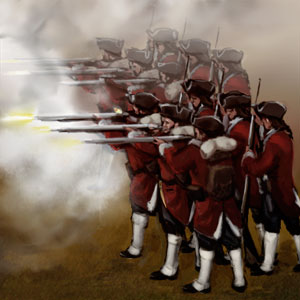Einheiten
Am Dienstag, 10. Feb 2009 im Topic 'Empire'
Land
Elite Light Infantry:Light infantry forces form a skirmish line to slow the enemy advance and keep their own line unmolested by enemy skirmishers.
Whether they are called light infantry, jaegers, tirailleurs or chasseurs à pied, it is the job of these men to screen the main battle line, harass the enemy and, if possible, pick off important men in the enemy’s ranks. Unlike their fellows in the line infantry, light infantrymen are trained to think for themselves, use the ground and cover intelligently, and not fight in rigid lines. Instead, they form a loose skirmish line and fire independently at their own designated targets. The effect is a constant, low-level barrage rather than the crashing thunder of a volley but the effect is quite deadly as officers and sergeants are picked off and removed from the fight. Against cavalry, however, their best defence is to withdraw to their own battle line.
Historically, the Austrians were widely regarded as producing the finest light infantry forces in Europe. Other nations did catch up, but in the case of Britain and France it was their experiences in fighting in North America that persuaded them of the wisdom of light troops. Battle lines were simply impossible to manage in the dense woodlands, and largely pointless against the native tribes!
Grenadiers:
Grenadiers are large, strong men, armed with muskets and carrying bags of bombs to hurl at the enemy’s ranks.
Explosive grenades are one of the oldest types of gunpowder weapon, and one of the most dangerous to use. Grenades are a simple cast iron ball, with a fuse sticking out of the top. Fuses are notoriously unreliable, and grenadiers can die as their own bombs explode prematurely. Yet no matter how terrifying grenades are for the throwers, they are infinitely worse for the targets! Grenadiers see themselves as elite, and occupy the place of honour at the right of the line on parade. They have good reason: only large, brave men become grenadiers, because it takes a big chap to throw one properly. Even their uniform makes them look bigger thanks to the pointed grenadier’s cap; a tricorne gets in the way of a good throw.
Historically, grenadier regiments and battalions began as ad hoc assault forces. All line infantry regiments had grenadier companies; collecting these sub-units gave commanders a useful group of heavily armed, aggressive and skilful soldiers. Grenadier companies remained in line infantry regiments after the creation of grenadier regiments, but they abandoned grenades. Instead, each grenadier company became a “heavy mob” of the biggest and strongest soldiers in a regiment.
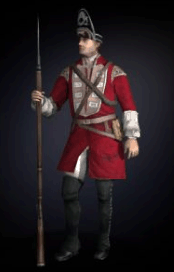
24-pounder Howitzer Foot Artillery:
Howitzers send shells plunging into enemy formations and over defences, making cover irrelevant.
Howitzers fall somewhere between guns and mortars, the other main artillery types. They have a limited mobility, like guns. Like mortars, they do not fire straight at the target, but send shots high into the air to plunge down on a target (and over anything in the way). By angling the barrel and changing the propellant charge used, howitzers have an impressive flexibility in shell trajectories. Experienced crews can lob explosive shells and incendiary rounds with great accuracy into a “beaten zone”, making life utterly miserable and very short for anyone within it. In close action, they can fire canister rounds directly into enemy formations, like giant sawn-off shotguns.
The term foot artillery applies because the gunners walk into battle alongside the draft animals. Like all artillery, the weight rating of these howitzers refers to the size of shot fired; a 24-pounder is worthy of respect!
Historically, howitzers – like many artillery pieces – were far from standardised weapons in the 18th Century. Shells and spare parts from in one foundry did not always fit another foundry’s pieces, even if the calibre was nominally identical. It took a good deal of effort and argument to get foundries to standardise barrels and ancillary equipment, even in one country.
Clansmen
These fierce Highland warriors intimidate all enemies with their wild skirling attacks and barbarous apparel.
Highland clans are the last tribal society in Western Europe. Men fight for their chieftains because they are expected to defend their clans’ honour and lands. They fight for these in the same way that they have done for centuries: with the broadsword and buckler, pistol, and Lochaber axe. There is little that regular line troops find as disturbing as the sight of a clan bearing down on them, screaming their hate and defiance. Highland Scots are brave, hard men.
Historically, the clans were destroyed as a military force at Culloden in 1746, by both British regulars and other, loyalist clansmen. The romance of the clans died on the field, along with a great many men who hurled themselves into a storm of lead and cannonballs armed with nothing more than swords. The clansmen were then repeatedly betrayed and used by their own chiefs, and then eventually driven off the land when sheep became more profitable. Highlanders were forced to scatter across the world, taking their fighting traditions with them.
Wasser
Sloop
A sloop of war is usually ketch-rigged with two masts. These small vessels handle well in restricted waters.
The ability to navigate in exceptionally shallow or dangerous waters makes sloops very useful in such seas as the reef-strewn waters of the Caribbean. They can also operate without the need for extensive onshore naval facilities nearby. They are also extremely useful as fleet auxiliaries, carrying out communications tasks and vital inshore scouting work, and can hunt down smaller prey such as privateers and small enemy cargo vessels. A sloop-of-war (sometimes a corvette in French service) is a different vessel from a civilian, merchant sloop, having a flush deck, two square-rigged masts, guns, and a larger crew.
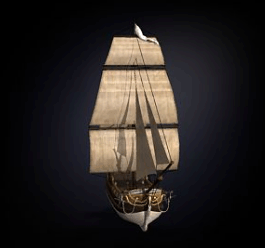
Historically, a post captain would rarely command a ship this small. The commanding officer was the “master and commander” (this is the origin of the modern naval rank of commander), and held the formal rank of lieutenant. Captain Cook RN commanded HMS Resolution, a sloop converted from a collier (coal ship), on his epic Pacific voyages and was highly satisfied with its performance. Sloop captains could be aggressive: before his promotion to post captain, Thomas Cochrane commanded the 14-gun HMS Speedy and managed to capture “El Gamo”, a Spanish xebec of 32 guns with a crew six times larger than his own!
Fifth Rate
Frigates are single-deck warships, used for a variety of tasks thanks to a combination of good handling, firepower and endurance at sea.
“Fifth rate” is a Royal Navy term for the largest of the single-deck frigates, square-rigged ships that carry some 44 guns, usually no heavier than 12-pounders. Originally a French design – but quickly adopted by the other European powers – the frigate is used for pursuit, convoy protection, commerce raiding and reconnaissance work. The design’s excellent sailing characteristics and good handling, especially in inshore waters, make it a useful addition to any blockading fleet. The frigate’s ability to operate far away from a home port also makes them it a useful cruiser, carrying the fight to the enemy in unexpected waters.
Frigates can have the advantage over larger, two-deck ships in rough waters. A frigate captain rarely has to worry about his gun deck taking on water, and can therefore fight in conditions that leave bigger ships at a disadvantage. However, fifth rates are not powerful enough to face battleships. They have the speed and handling to stay out of trouble; they do not have the strength of construction to survive a pounding! Against sloops, brigs and merchantmen, however, they are deadly. This makes them excellent postings for officers hungry for prize money and glory.
Frigates captains made splendid role models for fictional heroes: Thomas, Lord Cochrane earned a fortune in prize money, gained the nickname “le loup des mers” (sea-wolf) and was the inspiration for fictional heroes Horatio Hornblower and Jack Aubrey.
Razee
A razee is a robust frigate, created by cutting the top deck off a larger ship of the line.
Frigates are a vital part of any balanced sea-going fleet. They are cruisers that can operate independently and are swift enough to hunt down enemy merchantmen. the chance for prize money makes them popular postings among officers and men alike!
One way of creating a large, powerful frigate is to take a two-deck ship of the line and, in effect, saw off the top deck creating a single-deck frigate. The first result is that a 64-gun ship can now only carry 44 guns, but the ones that remain are the heavier than those normally found on a frigate, typically 32- or 24-pounders rather than the expected 18s! The second result is that the razee retains the strong timbers of the original 64, making it a robust ship in combat. Thirdly, having lost its upper works, the new ship generally handles rather well under sail. All this work takes time and valuable dock space, of course.
Historically, one of the most successful razees was HMS Indefatigable, commanded by Edward Pellew. In the company of another frigate, Pellew took on - and defeated - the Droits de l'Homme, a French 74, in 1797. During the next year or so, Pellew and the Indefatigable went on to take a further nine vessels.
First Rate
The first rate is the largest type of “ship of the line of battle”, intended to be the centre of any fleet. These are very expensive and powerful vessels.
While these warships are among the most powerful vessels afloat, they are poor sailors, being both slow and unresponsive. This is not a serious shortcoming because, armed with around 100 cannons firing 32-, 24- and 18-pounder balls on their three decks, they can fire a terrible and destructive broadside. They carry a crew of over 800 sailors, gunners and marines and have more artillery than most land armies. Their cost, however, is a drawback and few navies can afford to build or maintain more than a handful of them.
Historically, first rates were never common, and hardly ever sent to overseas stations. They existed purely to fight in set-piece battles, and were not used for mundane duties such as protecting merchantmen, policing the seas and hunting down privateers.
Gebäude
Star Fort
The basic concept of a star fort is that at least one, and preferably many, field of fire should cover every part of the defence and the approaches to the fort. These killing zones can be extended and made even more deadly by, at the very least, a long sloping glacis around the fort for the attackers to scale. The glacis need not be very steep at all, but the attackers face an uphill struggle with no cover at all, under murderous fire ever step of the way. The glacis also acts as a passive defence, a sloping armoured earthwork for the fort proper. Beyond the glacis a hidden counterscarp awaits: a retaining wall (sometimes with firing positions for the defenders) that drops down deep ditch that must be crossed before the actual approaches to the fort are even reached!
All of these defences are before the military architects add additional ravelins (detached triangular bastions or gun positions) in front of the fort’s own walls and hornworks and crownworks (both elaborations on the basic bastion design). The whole effect, when viewed in plan form, is baroque in its complexity, each projection of the central star giving the defence another firing position towards any attacking force. Wall length is limited to that which can be covered by flanking musket fire, as experience showed that a fort with only cannons in its defence could be taken when the cannons were knocked out
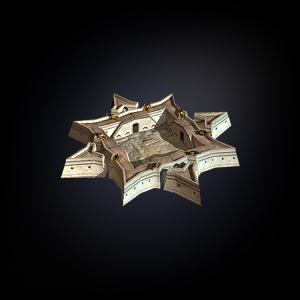
University
Education is vital for those who wish to enter the professions, or make their way in government using talent alone. A good, well-trained brain is an excellent substitute for birth and social connections. A young gentleman’s studies can be wide ranging, and need not be tied to any particular faculty or subject area – an awarded degree or doctorate is proof enough of intellectual achievement.
Historically, in Europe at least, the established church controlled most universities, either through paying for them or by laws requiring the tutors to take holy orders. Sir Isaac Newton was very unusual in that he didn’t take orders when he was appointed Lucasian Professor of Mathematics at Cambridge (a post currently held by Stephen Hawking), arguing that the post required the holder to spend time on science, not the Anglican Church. However, the requirement for teachers to accept Church doctrine did mean that universities had a socially conservative outlook. While scholarships were available, students had to have money to attend, reinforcing this conservatism. While wild, threatening ideas about the world and the way it worked did emerge from universities, the institutions were rarely radical or revolutionary breeding grounds.
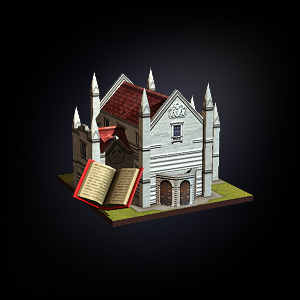
Trading Port
Shipping goods of any kind by land is difficult and expensive. Any item that has to travel more than a few miles goes by ship wherever possible.
Most roads are simply terrible, and bulk cargoes (such as coal) must go by ship anyway: it is the only way of moving goods cheaply and relatively quickly. It also makes the whole world a marketplace, even if the customers are not sure what to make of the goods they are being sent (British merchants insisted on exporting heavy woollen cloth to India for years, even though there was no obvious market for it).
Coastal trade can also be very profitable. For example, a “cheese fleet” did nothing but shuttle back and forth between London and the northwest of England, bringing Cheshire cheeses to the London market. By a happy accident of geology, Cheshire had rock salt mines that provided a preservative for the local cheese to make the sea journey to London. Although salty, this was undoubtedly healthier than most food on a gentleman’s table in the 18th Century!
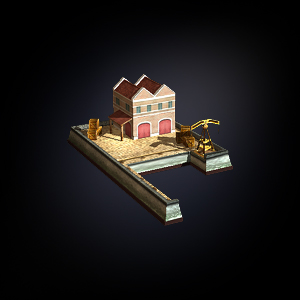
European-style tenanted farms
Tenanted farms can only generate so much income from rents. With an increase in town size, and an increased demand from industry for agricultural products, it is more profitable to have herds of animals, not a gaggle of tenants. Meat and wool demand increases rapidly as towns grow. Apart from any other considerations, moving people off land also creates large areas where landowners can indulge a passion for hunting. While this generates little income, it does give social status.
The “Highland Clearances” are probably the most famous example of a forced change to land usage on a large scale. Contrary to popular belief, Highland clan leaders carried out most of the Scottish clearances, driving their own kinsmen and clans into exile. The chieftains needed to pay for the sophisticated life that they could have in Edinburgh and London by reinventing themselves as Scottish gentry. Sheep simply earned more money than the crofters did.
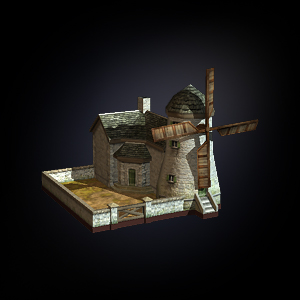
Technologien
Fougasse
This defensive weapon is a landmine constructed by military engineers and fired by the defenders lighting a fuse.
A fougasse consists of a pit, sometimes dug at an angle, with gunpowder packed into the bottom and suitably wrapped to keep it dry. The hole is then backfilled with rubble and stones, taking care not to break the fuse, creating a huge “canister shot” weapon. Any enemies caught by the explosion are blown to smithereens by the blast. Damp, of course, will cause the fougasse to misfire, like any other gunpowder weapon.
Historically, a later and nastier, refinement used a flintlock mechanism to fire the charge. As well as making the explosion more reliable, this allowed military engineers to turn the fougasse into a booby trap. A piece of twine tied to the trigger acted as a tripwire: an unfortunate booby then stumbled and fired the device into himself and his nearby comrades.
During the 20th Century, the fougasse was refined into a flamethrower by burying oil drums on top of the explosives. And at the time of writing, the fougasse remains in use, as only one of the IEDs (improvised explosive device) used by insurgents against occupying forces in Iraq.
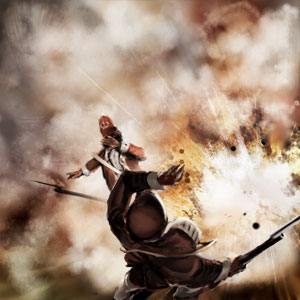
Square Formation
A defensive posture for musket-armed infantry units, creating an impassable wall of steel to fend off cavalry attacks.
As the name suggests, this is four two- or three-rank lines of infantry arranged as a hollow square, with everyone facing outwards. It is a version of the obsolete pike “hedgehog”, making any cavalry charge a suicidal exercise. Bayonets are fixed to muskets when appropriate and possible.
Forming a square requires good order in the ranks. The outer companies of an infantry unit in line have to “fold back” to form the sides and back of the square, without losing cohesion in the process. The unit colours take up station in the centre, a final rallying point should the square be broken. It is also possible to form larger squares with more than one unit.
The square is, of course, a tempting target for enemy artillery. Whether it is better to form square in the face of cavalry and risk an artillery barrage, or stay in line to mitigate artillery fire and risk a cavalry charge can be a tactical conundrum!
Theoreticians argued infantry could defeat a cavalry charge by firepower alone. Brigadier General Richard Kane (later Military Governor of Gibraltar) remarked, “If a body of Foot have but Resolution and keep their Order, there is no Body of Horse dare venture within their Fire…” but for him that fire was to be delivered from a square, not a line. He was arguing for discipline as the key to success.
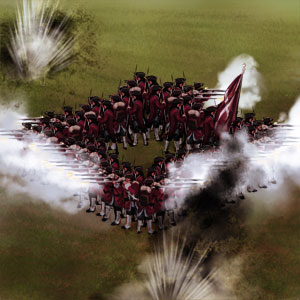
Platoon Firing
This firing plan for musketry ensures an infantry unit keeps up a continual barrage of shots against an enemy.
Nearly all line infantry carry smoothbore, muzzle-loading muskets. These take considerable time to reload after firing: anything up to a minute for poorly trained or nervous troops. During that time, the enemy can close or return fire unmolested. In the time it takes to reload, a unit can be cut down, its half-loaded weapons useless in the face of an aggressive foe. It is sensible to make sure that not everyone in an infantry unit is reloading at the same moment; this, in turn, means that not everyone should be firing at the same time.
Platoon fire is a way of dividing a unit into smaller groups that each fire, reload and fire again in turn. The result is a “rippling fire” down a line formation and, as the last platoon fires its muskets, the first is ready to fire again. A unit can always give some fire to the enemy at all times, even if this is less than a complete volley. When more than one unit is involved all the troops in every first platoon fire, followed by all the second platoons, and so on, creating several rippling barrages down the battle line.
The word “platoon” in this context does not have the modern meaning of being a sub-unit of a military company. Platoon assignment to what was a “fire group” was made on an ad hoc or informal basis, and could mean a whole regiment being assigned to a “platoon”.
